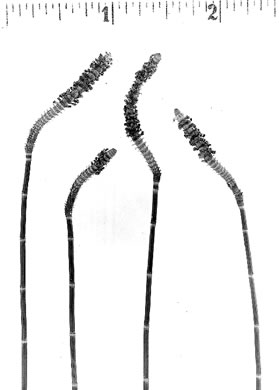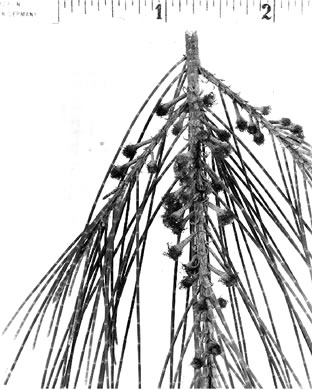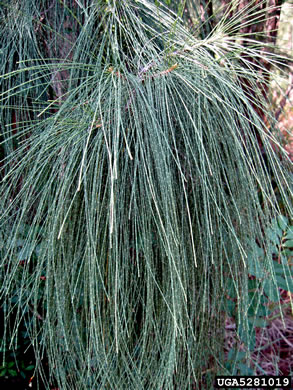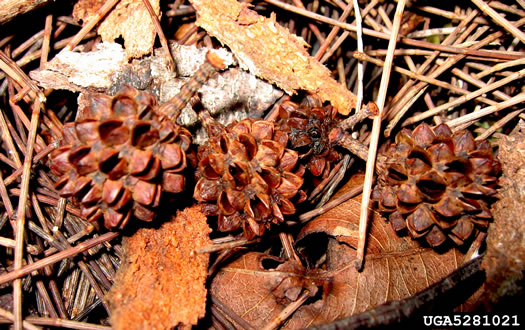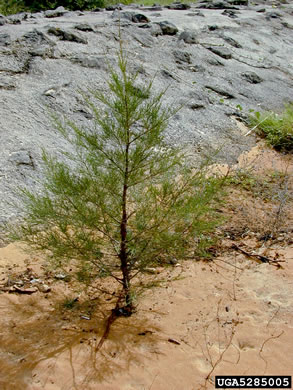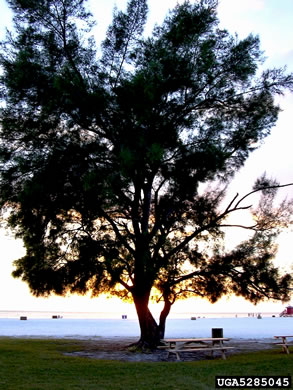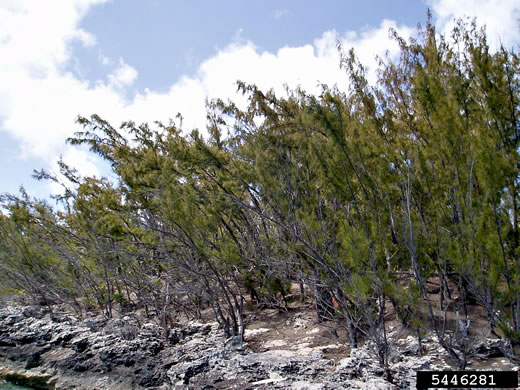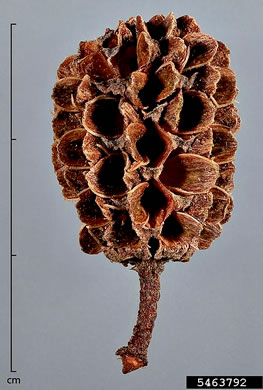Spermatophytes (seed plants): Angiosperms (flowering plants): Eudicots: Core Eudicots: Rosids: Fabids: Fagales
WEAKLEY'S FLORA OF THE SOUTHEASTERN US (4/24/22):
Casuarina equisetifolia ssp. equisetifolia
FAMILY
Casuarinaceae
Go to FSUS key
Dig deeper at SERNEC, a consortium of southeastern herbaria.
Read about Casuarina at wiki.bugwood.org
Check out EDDMapS.org to see where this has been reported.
INCLUDED WITHIN
PLANTS NATIONAL DATABASE:
Casuarina equisetifolia
FAMILY
Casuarinaceae
INCLUDED WITHIN Floristic Synthesis of North America. BONAP (Kartesz, 2021)
Casuarina equisetifolia
SYNONYMOUS WITH Flora of North America
Casuarina equisetifolia ssp. equisetifolia
INCLUDED WITHIN Manual of the Southeastern Flora (Small, 1933, 1938)
Casuarina equisetifolia
COMMON NAME:
Australian-pine, Horsetail Casuarina, Beach She-oak, Coastal She-oak
To see larger pictures, click or hover over the thumbnails.
W.D. Brush / USDA-NRCS PLANTS Database pnd_caeq_010_lvp
Male flowers are borne in slender cylindrical spikes at the twig tips, per www.wiki.bugwood.org.
W.D. Brush / USDA-NRCS PLANTS Database pnd_caeq_011_lvp
Female flowers occur in lateral heads on non-shedding branchlets, per www.wiki.bugwood.org.
Dan Clark, USDI National Park Service, Bugwood.org bug_5281019
Month Unknown
Its very slender green twigs resemble pine needles, but it is not a pine, per Invasive Plants, Guide to Identification, Impacts and Control (Kaufman & Kaufman, 2007).
Dan Clark, USDI National Park Service, Bugwood.org bug_5281021
Month Unknown
Peak bloom in April, a lesser one in September. Some fruit present any time, per Invasive Plants, Guide to Identification, Impacts and Control (Kaufman & Kaufman, 2007).
Forest and Kim Starr, Starr Environmental, Bugwood.org bug_5285005
Month Unknown HI
Reported for AL in 2012, "definitely naturalized and suckering", per Weakley's Flora (2015).
Forest and Kim Starr, Starr Environmental, Bugwood.org bug_5285045
Month Unknown FL
Can grow 10' in a year, and in 5 years is producing thousands of seeds, per Invasive Plants, Guide to Identification, Impacts and Control (Kaufman & Kaufman, 2007).
Leslie J. Mehrhoff, University of Connecticut, Bugwood.org bug_5446281
Month Unknown
Shallow-rooted and inhibiting the growth of native dune-stabilizing plants, per Invasive Plants, Guide to Identification, Impacts and Control (Kaufman & Kaufman, 2007).
Christina Southwick, Dried Botanical ID, USDA APHIS ITP, Bugwood.org bug_5463792
Month Unknown
Half-inch fruits look like rounded cones and contain 70-90 light flat seeds, per Invasive Plants, Guide to Identification, Impacts and Control (Kaufman & Kaufman, 2007).
WEAKLEY'S FLORA OF THE SOUTHEASTERN US (4/24/22):
Casuarina equisetifolia ssp. equisetifolia
FAMILY
Casuarinaceae
INCLUDED WITHIN
PLANTS NATIONAL DATABASE:
Casuarina equisetifolia
FAMILY
Casuarinaceae
INCLUDED WITHIN
Floristic Synthesis of North America. BONAP (Kartesz, 2021)
Casuarina equisetifolia
SYNONYMOUS WITH
Flora of North America
Casuarina equisetifolia ssp. equisetifolia
INCLUDED WITHIN
Manual of the Southeastern Flora (Small, 1933, 1938)
Casuarina equisetifolia
If a search such as "Carex leptalea var. leptalea" doesn't deliver the results you want, try "Carex leptalea".
Or, to minimize chances of a misspelling, try just "Carex le".
Less is more: If "pencil flower" doesn't deliver the results you want, try "pencil".

